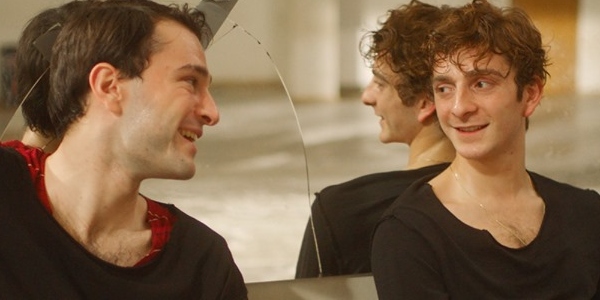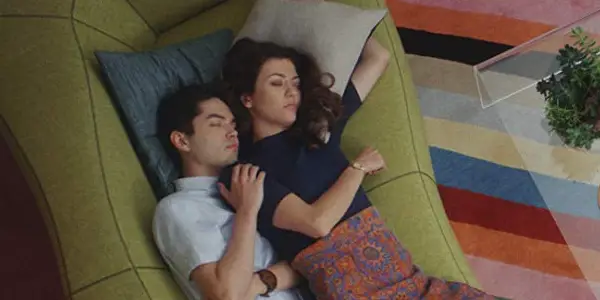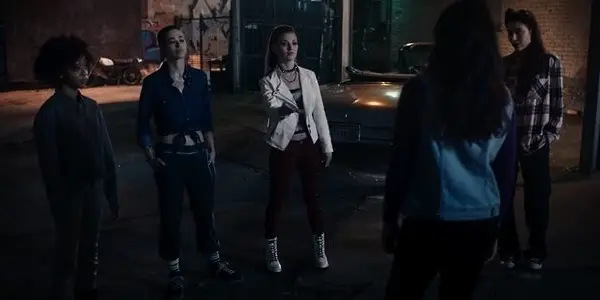NewFest LGBTQ: AND THEN WE DANCED, STRAIGHT UP & BIT

Andrew Stover is a film critic/writer from the Chicagoland. His…
The following three films premiered at the 31st Annual New York LGBTQ Film Festival on October 26, 2019: And Then We Danced, Straight Up & Bit. Reviews follow.
And Then We Danced (Levan Akin)

Levan Akin’s And Then We Danced is a coming-of-age love story that transpires in Georgia, a country that forbids discrimination against LGBTQ people, but more often than not, triggers violent discourse of sexuality amongst religious folk. Unfortunately, even with laws in place, homosexuality is still seen as an unforgivable departure from traditional Christian values in Georgia, and hate crimes still ensue because of it. Treated with compassion, Akin’s love story is a heady tale of identity that elegantly engages with intoxicating dance and unavoidable human impulse.
Merab (Levan Gelbakhiani), a young Georgian dancer, is first seen dancing to customary Georgian music, until being abruptly criticized by the forbidding dance instructor, Aleko (Kakha Gogidze), for not wearing the habitual Georgian-dancer mien (“You should be like a nail”). His bearing is too supple and his style too colorful. Suddenly, Merab is beguiled by Irakli (Bachi Valishvili), a new student Merab begins developing feelings for. We would soon learn Merab is part of a family of ill-fated dancers: separated parents Teona (Tamar Bukhnikashvili) and Ioseb (Aleko Begalishvili), along with his affable grandmother (Marika Gogichaishvili), were professional dancers, only for their careers and passion to slowly corrode. Merab communicates a stiff, unyielding ardor and heart through dance, convincing you he’s not his parents. Maintaining a waiter job and working endlessly to join the National Georgian Ensemble, it isn’t until the alluring presence of Irakli surfaces that Merab faces his greatest rival, as well as his most spiritually forbidden yet completely natural desire.
And Then We Danced is a delicate and soul-stirring picture, utilizing dance as expression and power. In a country where Merab’s love for another man isn’t legally locked up in shackles, but still generally denounced in a harshly conservative society, Merab’s homosexual feelings were bottled up tightly, but Irakli’s gentle, peppy spirit exhumes Merab’s hidden desires. Dance has to do with the physicality, fervor and emotion of the artist. Young Georgian actor/dancer Levan Gelbakhiani puts on a myriad of faces and dances with such grace and agility. His fluctuating emotions are radiated through dance and face acting, artfully captured by cinematographer Lisabi Fridell (Something Must Break), who evokes free-flowing camerawork that properly aligns with the emotionality of the characters. The camera constantly attaches itself to Merab’s nuanced face and expressive body movements in an oscillating fashion, and it’s all the better for it considering Gelbakhiani gives a remarkable lead performance.
When Irakli traipses into Aleko’s dance studio, he carries a sense of intrigue. Irakli is a talented dancer, immediately replacing Merab in a duet. The rivalry is definitely there, but the sexual tension between them fills the aura of the studio instead of pernicious competition. Despite facing off against each other to secure a spot on the National Georgian Ensemble, they strike a connection. Gelbakhiani and Bachi Valishvili have endearing chemistry, conveying their blossoming feelings through rousing dance and time spent hanging out with friends (where they would then sneak off from the group and give in to their disallowed emotions). At one point, Robyn’s poppy tune Honey is employed during a scene where Merab playfully dances for Irakli, which is disappointingly cut short — which brings me to the questionable editing choices. Another dance scene cut short is when Merab and Irakli infiltrate a dance circle on the street. Beyond a few scenes, the editing is fluid and juggles the intricacy of Merab’s search for identity in a hidebound society. Overall, Merab’s evolution from a guarded, accustomed Georgian dancer to a lyrical dancer with political vim, is neatly structured.
As for the actual direction, there are some evidently pesky clichés (or conveniences): Merab’s supportive and tenderhearted best friend Mary (Ana Javakishvili), and Merab’s no-good brother (Giorgi Tsereteli) who can’t do anything right. These characters come and go inorganically, and moments in which Merab and Irakli run into each other seems far too serviceable to the plot. But Levan Akin knows how to outline the acting/dancing chops of Gelbakhiani and Valishvili in an emotionally resonant manner. Merab and Irakli’s sincere compatibility overcomes the film’s more tired elements.
Levan Akin’s And Then We Danced is a bold and crucial snapshot of romance, captured, framed and packaged for Georgia, a country in need of change. Love conquers all. In the final scene, dance serves as a political statement, one that doesn’t resort to violence, but pure art. Art reflects society and the attributes that helped foster its existence, and in many ways, And Then We Danced is romantic, sensual, poignant, and holds a mirror up to Georgia.
Straight Up (James Sweeney)

In James Sweeney’s Straight Up, he takes on the role of director, writer and leading actor, giving us a quirky rom-com where distorted labels perpetuate the core relationship between Todd (Sweeney) and Rory (Katie Findlay). The Los Angeles-set rom-com revivifies the subgenre with fresh musings about identity and how relationships function. Even in times where it seems like the movie’s rambling without much heed or purpose, Sweeney’s brisk, kooky and tartly funny style (framed in 4:3 ratio and compiled by static shots) does make up for the neglected substance — but that’s not to say it doesn’t still measure sufficient proportions of truth.
Since second grade, Todd has been called gay. Maybe it’s true, maybe it isn’t, but Todd’s also not a fan of sexual intercourse (one of his greatest fears is bodily fluids). Every week, he visits a psychoanalyst (who tells him, “You’re in an emotional wheelchair”) to discuss his numerous fears with incredible haste. Todd is characterized by his obsessive-compulsive disorder, great perspicacity, various aversions and hopeless attempts to pick up on social cues. Dishearted by same-sex relationships, he wanders aimlessly into the straight dating game. His friends around him are not supportive of his latest interest in the opposite sex, thinking he’s suffering from internalized homophobia.
Despite what others say, Todd does meet someone, an aspiring actress named Rory. Together, they develop a mutual relationship flourishing on every level but sexual contact. Sexual desire aside, is it possible for Todd and Rory to be soulmates? If sex was off the table, is their love for each other’s personalities, their love for needless discourse of what constitutes as ironic, and their love for celibacy, vigorous enough to overcome any need for sexual intercourse? Straight Up defies what a relationship commonly looks like — revealing where a relationship’s most vital facets lie but also circling back to the ineluctable allure of sexual intimacy.
Harnessing fast-paced line delivery and outspoken dialogue, Todd and Rory’s conversations are meant to underscore how quick they think and how everything they say must be insightful. But so much scattered maundering on a number of random topics and hypothetical questions ends up getting a bit tiring. As Todd and Rory navigate their offbeat relationship, they confuse Todd’s friends, including Ryder (James Scully), who’s rather obnoxious and insensitive, and Meg (Dana Drori), who’s flighty and frivolous. Radically different from his friends’ reactions, Todd and Rory’s relationship gratifies Todd’s racist father (Randall Park), who seems to be immensely happy that his son isn’t dating a man anymore. There’s no doubt in how well they operate together, but the people orbiting their oddball romance have opinions, some better concealed than others. So much ill-advised judgment from those who aren’t Todd and Rory, who aren’t capable of knowing what and how they feel. Unfortunately, nuggets of substance are lost because, like Todd, the film carries on even when a detour or one of Todd’s dour thoughts emerges.
Sweeney’s persnickety performance as Todd is appropriately strident and critical. He talks without limits and stands tall and poised when walking. There isn’t a malfunction in his step or the slightest sense of regret in what he says (or even how he says it). Katie Findlay’s performance as Rory is just as wacky and loud, but more grounded in how her character’s feeling; she’s more hard-nosed and has a firmer grip on her words. Sweeney and Findlay delightfully balance each other’s dispositions out, pretty much like an actual couple.
Preserving an airy tone and clever 4:3 box ratio, production designer Tye Whipple situates the characters in capacious, lived-in rooms, symmetrically arranging each piece of furniture and positioning Todd and Rory where it appears most impactful. One scene, in particular, has Todd and Rory laying on separate sides of the bed, and as they start conversing about idioms and sex (and the lack thereof), the camera shifts between characters. The rapid transitions between Todd and Rory, who are sitting on opposite ends of the bed, allows them to have their own personal space, even on a narrow mattress where sexual intimacy is regularly expected. Both sides are strikingly uniform, and this kind of symmetry is consistent throughout.
As Todd and Rory struggle to adapt to a sexless, label-less romance, their spiritual connection persists on without any doubt. Although the ending doesn’t provide a conclusive statement of their love — and whether or not it’s a feasible undertaking — all I know is that their souls coexist smoothly, without many rough edges or scornful silence rendered out of sex deprivation. James Sweeney’s Straight Up is overtly weird and implies honesty when it comes to what makes an ideal relationship work, despite getting jumbled in its expeditious, garrulous execution. Todd’s involuted mind and inner thoughts are deftly put into film, but not all depth is untangled and straightened in a clear-cut manner.
Bit (Brad Michael Elmore)

The vampire craze has dialed down ever since Twilight ended. When the haze was in full effect, vampires were being exploited for teen melodrama and love stories laced in blood and existential turmoil. Spending days rotting alone, the genre found writer-director Brad Michael Elmore, who doesn’t exactly reanimate the genre to its previous glory with Bit, but he summons a deliciously punky and grubby feminist spin on Joel Schumacher’s The Lost Boys.
Laurel (Nicole Maines) is a teenage trans girl traveling from Portland to Los Angeles to spend the summer with her brother Mark (James Paxton). One night relishing the party scene L.A. has to offer, quickly gets Laurel mixed up with a bunch of queer punk vampires. Tempted by Izzy (Zolee Griggs), Laurel expects a quick hook up and nothing else, but instead, she’s bitten and left for dead. At least until group leader Duke (Dianna Hopper) intrudes, and wants Laurel to join their private, girls-only vampire circle. As Laurel begins transforming into a vampire, she learns that they have a strict policy: Never glamour another vampire to influence their decisions; kill what you eat; never turn a man. Becoming a vampire threatens Laurel’s relationships and morality, but there’s no going back now.
Bit still chiefly utilizes the traditional vampiric mythology (no sunlight but the vamps here can still endure it without dying, piercing teeth, eternal life, heightened senses and strength), but proceeds forward as a feminist revenge fantasy, where the female vampires sink their teeth into deserving men who abuse their power. On the surface, Bit is a sardonic vampire tale pouncing on the most vulturine men in a fashion that’s bleakly arresting and occasionally blood-soaked. But beneath the writ large horror and guiltless ire, Elmore’s execution is fairly pithy. The pro-female messaging is supported by an intriguing and powerful lead.
The set-up to Laurel’s transition into a vampire is lightly echoed by another transition she underwent. Laurel is a transgender protagonist, but her transition is left primarily unsaid, leaving any tribulation she faced during her transition in the past. Laurel isn’t torn by past hardship, she’s strengthened because of it. Brad Michael Elmore’s definite allegory of a trans character evolving into a vampire and pinpointing their newly founded vigor after the demanding procedure, supplies the film with earnestness. What’s not so earnest, or exactly subtle, is the forceful digs at the toxic men who wield unregulated superiority. But these jaded digs aren’t supposed to be subtly uttered, predominantly because the female vampire clique is keen on following their beliefs that all men will misuse their given faculties as a vampire. The stern, unbending and unforgiving group leader, Duke, abides by this rule wholeheartedly, prompting Laurel to counter Duke’s perception in the end.
Nicole Maines gives an imposing lead performance as Laurel, who comes out of the shadows and demands change and empowerment in a series of twisty genre gambits. Dianna Hopper deploys a lot of much-needed arrogance and fashion (wearing the hell out of a white leather jacket) to properly suit the role of Duke, the vampire queen. In Bit, L.A. belongs to the punks, the outsiders, and elaborate punk clubs and vacant lots are highlighted the most. Lisa Norcia’s costume design tailors the vampires with punky clothing (leather jackets, ragged shirts, black boots). Like many other cinematic vampires who gather in a forbidding pack, they’re stylish and beguiling.
There aren’t many narrative risks taken, and the rules that hold the vampire pack together are destined to be broken (even the question of how is quite foreseeable). Laurel’s friendship with a long-time friend is left unresolved, and a rushed ending causes the dialogue to become labored, and the delivery flat. A confident and refreshing lead trans character sustains most significance by not being mired in internal torment. She’s fine with who she is and how she got through the past woe; that’s not important now. What is important now is dealing with the fact she’s a vampire.
Bit follows queer punk female vampires who seek the blood of corrupt men. It’s visibly satirical and brutal, but the film does hint to bigger, more progressive ideas. No matter how true it is that many men in leadership positions exploit their dominance, to say all men are vile creatures isn’t what Laurel, our strong-willed protagonist, ends up believing: “I picture a world where everyone’s a vampire. Maybe what everyone with power should do and never does: share it.” The message of unity and empathy is a little contrived by how it unfolds through hokey dialogue and ignored stakes, but it’s still pleasant enough.
Brad Michael Elmore boldly depicts Laurel as a trans character not defined by inward anguish, but by her drive to confront societal ills and come out stronger than she was before. Bit is much more than a typical genre film, it bites with robust feminine force and leaves a notable mark of representation, fused with bloodthirsty vampires and universal ambition.
Have you seen any of these films? Are you planning to attend NewFest 2019? Let us know in the comments!
The 31st Annual New York LGBTQ Film Festival goes from October 23-29. Get your tickets & passes now.
Does content like this matter to you?
Become a Member and support film journalism. Unlock access to all of Film Inquiry`s great articles. Join a community of like-minded readers who are passionate about cinema - get access to our private members Network, give back to independent filmmakers, and more.
Andrew Stover is a film critic/writer from the Chicagoland. His film & TV reviews can be found on Film Inquiry & Film Threat.













